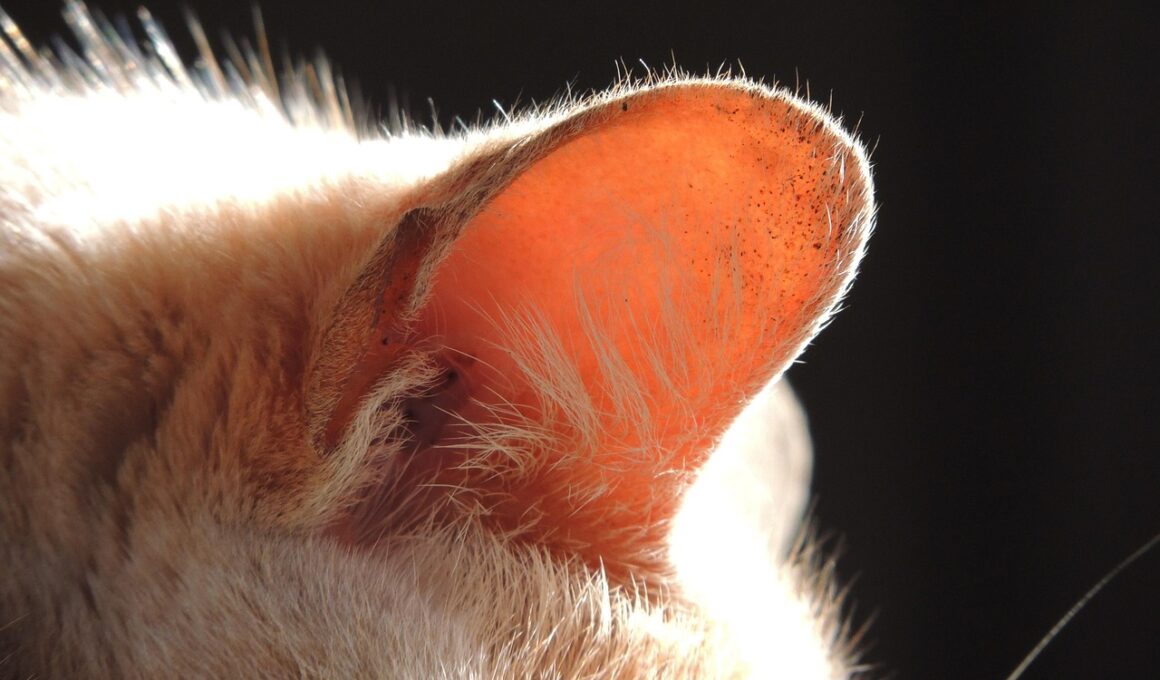Dealing with Ear Mites in Cats: Symptoms and Treatment
Ear mites are a common issue among cats that can cause significant discomfort if left untreated. These tiny parasites are not visible to the naked eye and tend to live in the ear canal, feeding on skin debris and ear wax. The first sign of an ear mite infection is typically excessive scratching at the ears or shaking of the head, both of which indicate irritation. Affected cats may also develop a dark, waxy discharge in their ears, which often resembles coffee grounds. It’s important to consult your veterinarian if you notice these signs, as they can confirm the presence of ear mites through an examination. Besides discomfort, untreated ear mite infestations can lead to more serious complications such as infections or hearing loss. There are several treatment options available, ranging from topical medications to thorough cleaning of the ears, which can effectively eliminate these pests. Early intervention is crucial in treating ear mites in cats and ensuring your pet remains comfortable, happy, and healthy. Understanding the symptoms and treatment options will guide cat owners in managing this pesky parasite problem effectively.
Once the presence of ear mites has been confirmed by your veterinarian, the next steps in treatment involve administering the appropriate medications. Generally, these treatments come in the form of topical solutions or drops that are applied directly to the affected ear. Your vet may recommend over-the-counter solutions or prescribe specific medications that are proven to be effective. It’s essential to adhere to the veterinarian’s instructions diligently, as proper administration of the medication can significantly impact its effectiveness. Most treatments require some degree of cleaning the cat’s ears as well, which removes debris and allows the treatment to work more effectively. Alongside topical treatments, it may also be necessary to treat other pets in the household, as ear mites can easily spread. Consult your vet about the best preventative methods and treatments for your specific case. In some instances, severe infestations may warrant additional treatments, such as injectable medications or oral therapies. By following the treatment plan as directed, you can help your cat find relief from ear mites and prevent future infestations that could compromise their wellbeing.
Recognizing Symptoms of Ear Mites in Cats
Recognizing the symptoms of ear mites early can make a significant difference in the treatment process for your cat. One of the most telling signs is persistent scratching at the ears, which indicates discomfort or irritation commonly associated with these parasites. As the condition progresses, you may observe your cat shaking its head or tilting it to one side as they attempt to relieve the itchy sensation inside their ears. Affected cats will also often have a foul-smelling odor coming from their ears, and some may exhibit signs of discomfort when their ears are touched. If you notice a dark, crumbly substance in your cat’s ears, it is likely a buildup of wax mixed with the remnants left by the mites. In some cases, severe infestations can lead to secondary infections, which will need veterinary attention. Because ear mites are contagious among pets, prompt recognition and treatment are paramount not only for your cat’s comfort but also to prevent spreading among other animals. Regular checks of your cat’s ears play a vital role in early detection and maintaining their overall health.
In addition to physical symptoms, behavioral changes may also hint at ear mites in your cat. You may notice increased irritability, anxiety, or changes in eating and playing habits when they are experiencing discomfort. A cat in pain may hide or become withdrawn, which can be upsetting for any pet owner. Maintaining regular veterinary visits can help catch these issues before they escalate into something more serious. If your cat exhibits such symptoms alongside visible signs of ear mites, it’s crucial to seek veterinary assistance immediately. Other potential causes for similar symptoms, such as allergies or bacterial infections, could lead to misdiagnosis if not properly evaluated by a professional. Your vet can perform thorough examinations and diagnostic tests to differentiate between ear mites and other underlying issues. This ensures effective treatment that addresses the root cause of the problem while keeping your cat as comfortable as possible. The sooner you act on these symptoms, the better the chances for a quick and effective recovery for your furry friend.
Home Remedies and Preventive Measures
While veterinary care is critical in addressing an ear mite infestation, some home remedies can support the process and prevent future occurrences. One popular method is cleaning the ears regularly with a gentle cat-safe ear cleaner that can help maintain ear health and reduce debris buildup. Create a habit of performing ear checks as part of grooming sessions, looking for discoloration or unusual waxy buildup. Ensure your cat’s living environment is clean and free of potential parasites by vacuuming regularly and washing their bedding. Using flea prevention products as directed can also help restrict the likelihood of ear mites and other parasites. However, it is crucial to discuss any home remedies with your veterinarian before starting. Some substances can irritate delicate ear tissue or interfere with prescribed medications, causing potential harm. Additionally, ensure that any products used are specifically designed for cats, as some household items can be toxic. By fostering a proactive approach to ear health, you can help mitigate the risk of ear mites and support your cat’s overall wellbeing.
Maintaining your cat’s health not only entails managing current infestations but also adopting preventive strategies. Regular veterinary visits are essential for monitoring your cat’s overall health and spotting any potential issues early. Ensure to follow your veterinarian’s guidance regarding vaccinations, parasite control, and wellness checkups tailored to your cat’s unique needs. Utilize flea and tick medications as instructed to keep parasites at bay, reducing the chance of ear mites. Moreover, avoiding contact with unknown pets and practicing good hygiene can decrease the likelihood of reinfestation. If your cat attends a grooming facility or is in a boarding situation, ensure that the place follows strict hygiene standards. Experiment with different feeding and exercise routines to keep your cat happy and healthy, boosting their immunity. Additionally, being observant in your cat’s behavior and any changes in their ears helps you catch problems earlier. By combining preventative efforts with understanding the signs of ear mites, you can establish a stronger line of defense against these pesky parasites, ensuring a healthier, happier experience for your feline companion.
Conclusion
In conclusion, managing ear mites in cats requires vigilance, understanding, and appropriate medical intervention. Early recognition of symptoms significantly enhances the chances of a quick and successful treatment. Consult your veterinarian as soon as any signs of irritation or discomfort appear, ensuring that your cat receives proper care tailored to their condition. By adhering to prescribed treatment plans and exploring preventative measures, you can effectively combat ear mites and safeguard your cat’s health. Maintaining regular ear checks and a clean living environment can play a key role in prevention. Remember that the well-being of your pet should always be the top priority. Stay informed about ear parasite management, and ensure that your furry companion leads a comfortable and happy life. Being proactive not only helps in dealing with current issues but also fortifies your cat against potential future infestations. Invest the time in fostering a routine that prioritizes their health, and you will create a bond built on trust and care. This comprehensive approach will ensure your feline stays free from ear mites and lives its life joyfully and comfortably.
Ultimately, if your efforts to manage ear mites aren’t yielding results, do not hesitate to reach out to your veterinarian for further guidance. There’s no shame in seeking help, and sometimes a more aggressive approach may be warranted. Your veterinarian may provide alternative treatment options or suggest further diagnosis if needed. Trusting their expertise and experience can lead you to the best outcome for your pet. Additionally, engaging in educational resources about ear mites and other common feline issues can empower you as a cat owner. Understanding the lifecycle of ear mites can also lend insight into preventive measures that can be taken. By staying informed and summoning the veterinary resources available, you ensure that your cat receives the best possible care. Moreover, collaborating with trainers or behaviorists can lead to a better understanding of the stressors that may affect your cat’s health. Ultimately, a proactive approach while dealing with ear mites will foster peace of mind knowing you’re doing everything possible for your furry friend. Commit to exploring all avenues of care to ensure that your cat lives a happy and healthy life, free from the burden of ear mites.


